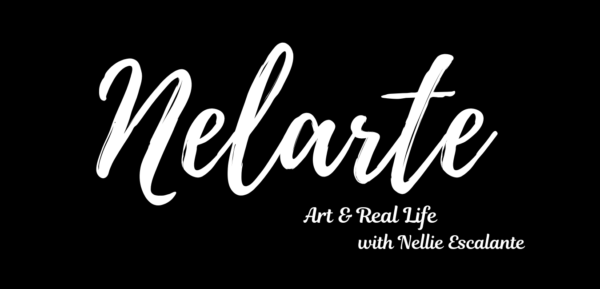
About the Art work
We see a man standing reading the newspaper. Behind him is a gate, taller than the man with, what seems to look like, tropical vegetation being kept from the man, peaking through the openings, and some managing to escape the gate and stand next to him on either side. What plants are these? At first glance I thought they were all palm trees but it looks to be a mixture of tropical vegetation. Certainly the tall ones can be palm trees but the others? As we look at other Báez’s works we can see a clue as to what type of plant it could be.

Maybe the plants are plantain trees like we see above. They look similar, right?
Myrna Báez interprets the Puerto Rican landscape on her own terms, often times fractured, or as in the main work, Noviembre, gated. She is not interested in nostalgia and longing. During this time, the political climate of Puerto Rico had shifted. Her work began to focus on the new middle class, exploring urban themes and an emerging Puerto Rican bourgeoisie. There is a sense of uneasiness where individuals depicted in her portraits of this period seem unsure of their new economic and social status.
What does the year 1976, in the title mean?
This is where the year 1976 comes in. This was the year when the pro-statehood party, New Progressive Party (PNP) came into power on the island. I wonder if the palm trees in the painting allude to this as the logo of the PNP includes one.

1976 was also the year that new tax codes (section 936) allowed American countries to thrive on the island, making profit without paying taxes. Puerto Ricans on the island became dependent on employment generated from this tax code.
Myrna Baez’s belief in Puerto Rican independence manifests in her impulse to depict the landscape in light of this political/financial shift. I wonder if this dependence on the US is what the artist is alluding to and the gated tropical vegetation refers to the end of reverence and dependence on the land. The landscape is also kept away from this person. What will happen to his cultural identity? Might it be held captive as well?
Who is the man in the painting?
The man in the painting is the father of a good friend of the artist, Pilar Reguero. Báez captured Reguero in the following work:

Reguero, reflecting on the work above says “When she made my collograph with three heads and three legs and I don’t know how many hands, I loved it and I thought it was great, it’s a representation of what I am, multi-dimensional.” And when asked about her dad she said, ” My dad was also one of her models, he took the prize, he loved posing…” Her dad also appears in the following work among others.

The sense of space and how individuals fit into that created space is a trend that continues in Báez’s work. Báez creates multiple dimensions in her prints and paintings, using frames, reflections, pictures on walls, and in this case, a gate signaling a place beyond, building layers of “unreal” space.
Reflection
Although I just mentioned “unreal space” there is a something familiar in this work. I usually ask participants during a museum program “what do you see?” one participant turned it around and said to me, ” what do YOU see?” I liked that, it gave me time to reflect.

What I saw was my father. My dad was always reading the paper. Here’s a picture of him, precisely in the 70s , like the painting , reading the paper.

In a world where we are getting our news from our cell phones and laptops, a newspaper is such a throw back. Just like my dad, this reading of the paper was perhaps part of this man’s identity.

His pastel suit could also be a way of him keeping his Puerto Rican identity amidst the cultural shifts happening to his island. Just as Baez, paints the landscape on her own terms, this man too will accept some of the coming changes to his country… but also on his own terms.
About the Artist
Myrna Báez (born August 18, 1931 – September 24, 2018) was a Puerto Rican painter and printmaker who lived and worked in San Juan, Puerto Rico. She is considered one of the most important visual artists in Puerto Rico and was instrumental in promoting art and art education on the island. Her work has been shown and collected by the Metropolitan Museum of Art, the Smithsonian American Art Museum and the Museum of Modern Art in New York.
